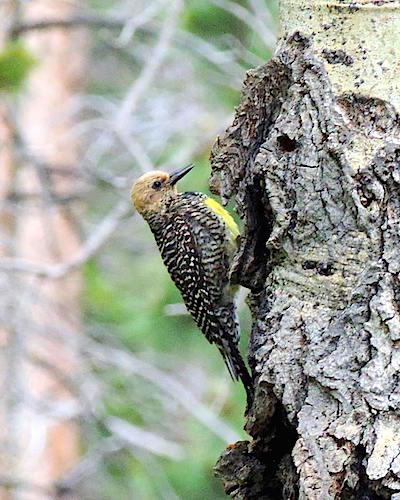
Williamson's sapsuckers are among the locals at Rocky Mountain National Park/Kirby Adams
There’s more to Rocky Mountain National Park than the extraordinary views from Trail Ridge Road. Willow-choked streams, open meadows, pine forests, and all the edges where those habitats meet make for a park bursting with birding opportunities. After a not particularly spectacular time up in the tundra, I enjoyed a couple wonderful birding days in two very different habitats last month. This is the story of the first of those days.
With an hour or so of daylight left one day, I ventured out to Upper Beaver Meadows on the advice of a bird-knowledgeable ranger at the Alpine Visitor Center. It was a pleasant evening stroll with Dusky Flycatchers and Violet-green Swallows patrolling the parking lot. The ever-present Broad-tailed Hummingbirds were zipping past constantly, sounding remarkably like the futuristic “car” from The Jetsons cartoons as they trilled past.
Heading up into the Ponderosas for a bit, I came across birds I fully expected, like Mountain Chickadees, and one that I did not expect, but perhaps should have: Williamson’s Sapsucker. A bird zipped past, clearly a woodpecker from its shape and undulating flight. A flash of a white rump made me think it was a Northern Flicker. We have flickers back east, but they are the yellow-shafted subspecies, while most of the Colorado population is the red-shafted. Since it’s always cool to see the bright red wing shafts, I followed the bird with my binoculars to the pine trunk it landed on and was surprised to see one of the more traditionally black-and-white patterned woodpeckers with a red chin. It hopped once and took off, but not before revealing a buttery-yellow belly.
My entire look at the perched bird lasted less than two seconds. My mind needed a moment to churn through woodpecker identification after it left, but there was no doubt. No other bird shares that plumage, so it had to be a Williamson’s – largest of the sapsuckers.
Being a woodpecker aficionado, this bird was high on my most-wanted list, and this was a lifer. It was also gone, about to be joined in absence by the light of day. With no time to chase the bird deep into the pines, I had to be ecstatic about a long-desired lifer and simultaneously disappointed at the brevity of our time together.
The next morning’s schedule was rearranged to include Upper Beaver Meadow as first priority. Woodpeckers are creatures of habit, and there was a good chance I could find this one again. Not long after dawn, I was back at the meadow. Just a few yards from where I had seen the sapsucker the evening before. A flicker zipped past again, but this was more certainly a flicker because it was a browner bird.
Except it wasn’t. My brain wasn’t making the connection between the male sapsucker I’d seen the night before and the fact that Williamson’s Sapsuckers are unlike most other woodpeckers in being starkly sexually dimorphic. The females look nothing like the males, being brown all over and sharing only the buttery belly with their masculine mates.
I got a good look at the female Williamson’s in a small Ponderosa Pine before it flew right in front of my face and right into a cavity in an aspen 20 feet away. My Williamson’s Sapsucker experience was about to go to a whole new level.
Over the next hour I watched the mother woodpecker bringing beakfuls of beetles back to the hole. When she’d fly away, the whining of unseen miniature sapsuckers trailed out of the cavity. The sound would have been lost to the wind if I hadn’t been sitting so close. Normally, I would not allow myself to remain that close to an active bird nest., as human presence can be very disruptive. In this case, the bird had made a food run while I was unknowingly standing at her front door, so I sat down to make myself less imposing and remained still and silent. The female showed not the slightest distress from my presence, so I gave myself permission to stay.
Eventually a male sapsucker flew in and perched on the aspen trunk opposite the female when she returned from a grocery run. Once she’d made her delivery and left again, he popped into the cavity and began doing the male’s work in the house – removing the fecal sacs.
Hatchling birds produce their solid waste encased in a thin membrane. This marvelous evolutionary adaptation makes nest hygiene far easier for parent birds. The job of removing the sacs, at least in woodpeckers, almost always falls to the male. On this morning I saw the male Williamson’s Sapsucker drop three sacs out of the cavity, making me guess there were three youngsters inside. The young produce the sacs almost immediately upon being fed and they are quickly removed.
That chore complete, the male flew off again. The female completed one more run to the nest, but then disappeared for several minutes longer than she had at any point before. I noticed a group of House Wrens milling around the bottom of the tree. Were they former residents of the cavity? Scavenging for leftovers among the woodpecker’s garbage?
I would have liked to have stayed and figured out what the wrens were up to, but the sapsuckers’ absence made me feel I may have overstayed my welcome. It was time to move along and let the lives (and deaths) of sapsuckers, wrens, aspens, and beetles fall back into the unobserved and anonymous expanse of the forest. Do hatchling woodpeckers make a sound if no one’s in the forest to hear them? I can’t answer that, but I sure am glad I stumbled into their world for a little while on an early summer morning.



Comments
Can you recommend any trails @ RMNP?